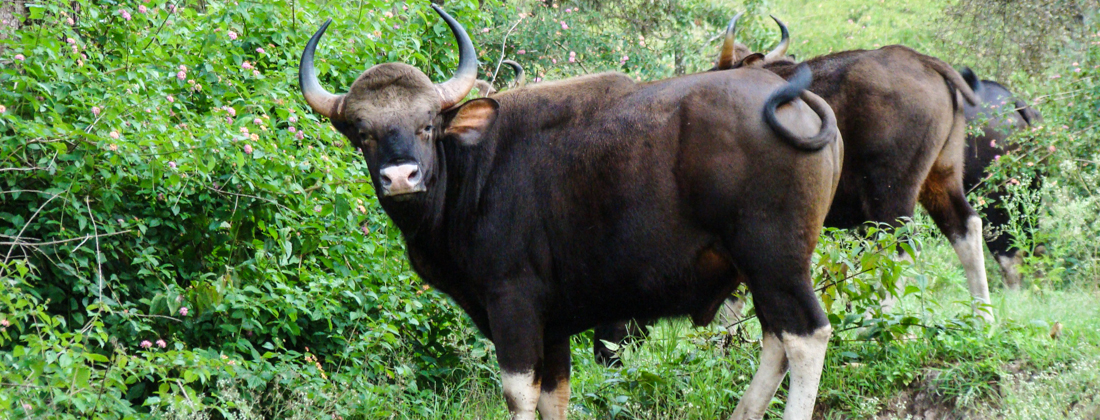
Experience South India
A three-week journey offering the best of Tamil Nadu, Kerala and Karnataka
Temples, palaces, places of pilgrimage, spirituality, tea plantations, spice gardens, wildlife and backwaters
This three-week adventure trip lets you gather impressions in three different South Indian states and combines outstanding cultural highlights with an intense experience of nature. Tamil Nadu is the land where deities are worshiped underneath imposing temple towers, bringing visitors close to the living spirituality of India. Kerala welcomes you to the lively, multicultural atmosphere of the Malabar Coast. And Karnataka captivates with delicate images of the gods, a fairytale Maharaja Palace and the austere beauty of the Jain shrines. This trip offers not only the varied highlights of a truly remarkable cultural heritage, but also a spectacular natural scenery. This includes fertile plains with green rice fields, bizarre rock formations, wooded mountainous regions, hilly tea plantations, spice gardens and abundant wildlife areas that are known for their large elephant herds. The backwaters of Kerala, fringed by palm groves and mango trees, offer a special experience of nature. A boat ride through the picturesque world of these waterways gives one of the most exciting impressions of South India. An unforgettable journey in which you experience the South of India in its kaleidoscopic richness!
The proposed itinerary is flexible and can be tailored to your needs in terms of content and schedule.
Chennai – Mahabalipuram – Tiruvannamalai – Pondicherry – Auroville – Chidambaram – Gangaikondacholapuram – Thanjavur – Madurai – Munnar – Thekkady – Backwaters – Cochin – Mudumalai – Mysore – Halebid & Belur – Shravanabelagola – Bangalore
Suggested itinerary:
Day 1: Arrival and transfer to Mahabalipuram
Your trip begins in Chennai, where you will be welcomed at the airport or train station and driven to your hotel in Mahabalipuram. The friendly atmosphere of the well maintained beach resort will help ensure that your arrival is a peaceful experience.
Day 2: World Heritage Sites in Mahabalipuram – Transfer to Tiruvannamalai
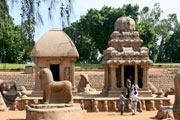 In Mahabalipuram (also called Mamallapuram) one can combine beach fun with a bit of cultural history. Situated directly on the Coromandel coast, the site is regarded as the cradle of South Indian culture and is a true archaeological treasure trove, with masterpieces from the Pallava period (6th – 8th century). In 1985, the monuments were declared a UNESCO World Heritage Site. Attractions include the Monolith temple and the Cave temple, with its magnificent imagery of the gods. It was the first temple in the region constructed from stone blocks. Large reliefs chiseled in granite narrate well known legends of Hindu mythology. The monolithic “Five Rathas” monuments served as architectural models on the basis of which the fundamental elements of Dravidian temple construction were developed. A huge boulder, located on a steep rocky ridge, is known as “Krishna’s Butterball” and presents a popular photo opportunity. Mahabalipuram is also a center of traditional sculpture. Indian statues of the gods in granite, marble and soapstone are still made by hand here in small family businesses. After the tour, a transfer to Tiruvannamalai follows.
In Mahabalipuram (also called Mamallapuram) one can combine beach fun with a bit of cultural history. Situated directly on the Coromandel coast, the site is regarded as the cradle of South Indian culture and is a true archaeological treasure trove, with masterpieces from the Pallava period (6th – 8th century). In 1985, the monuments were declared a UNESCO World Heritage Site. Attractions include the Monolith temple and the Cave temple, with its magnificent imagery of the gods. It was the first temple in the region constructed from stone blocks. Large reliefs chiseled in granite narrate well known legends of Hindu mythology. The monolithic “Five Rathas” monuments served as architectural models on the basis of which the fundamental elements of Dravidian temple construction were developed. A huge boulder, located on a steep rocky ridge, is known as “Krishna’s Butterball” and presents a popular photo opportunity. Mahabalipuram is also a center of traditional sculpture. Indian statues of the gods in granite, marble and soapstone are still made by hand here in small family businesses. After the tour, a transfer to Tiruvannamalai follows.
Day 3: Places of tranquility on the holy Arunachala mountain – Arunachaleshvara Temple & Ashram of Sri Ramana Maharshi
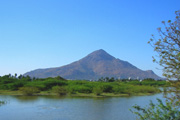 The pilgrimage town of Tiruvannamalai is situated at the foot of the holy Arunachala mountain, which is regarded as a manifestation of Lord Shiva. Ramana Maharshi, one of the most famous masters of Advaita Vedanta in the 20th century, lived at the Arunachala, and his ashram is known worldwide as a major center of Indian spirituality. A visit gives you an insight into the lively spirituality of the country. A footpath leads from the ashram to the holy mountain, where two chapels can be found that accommodated the master for many years and which visitors can access during the day for meditation. From the mountain, you have a wonderful view of the city’s Arunachaleshvara temple, where Shiva is worshiped in the form of the Fire element. The temple complex, divided into three courtyards, is among the most famous sanctuaries in Tamil Nadu. The oldest parts of the temple, which was completed in its present form in the 17th century, are typical of the Chola architecture and date back to the 11th century. The white color of the temple towers symbolizes purity. During full moon nights, Tiruvannamalai is a popular place of pilgrimage for several hundred thousand Hindus who, as per traditional practice, walk around the sacred mountain.
The pilgrimage town of Tiruvannamalai is situated at the foot of the holy Arunachala mountain, which is regarded as a manifestation of Lord Shiva. Ramana Maharshi, one of the most famous masters of Advaita Vedanta in the 20th century, lived at the Arunachala, and his ashram is known worldwide as a major center of Indian spirituality. A visit gives you an insight into the lively spirituality of the country. A footpath leads from the ashram to the holy mountain, where two chapels can be found that accommodated the master for many years and which visitors can access during the day for meditation. From the mountain, you have a wonderful view of the city’s Arunachaleshvara temple, where Shiva is worshiped in the form of the Fire element. The temple complex, divided into three courtyards, is among the most famous sanctuaries in Tamil Nadu. The oldest parts of the temple, which was completed in its present form in the 17th century, are typical of the Chola architecture and date back to the 11th century. The white color of the temple towers symbolizes purity. During full moon nights, Tiruvannamalai is a popular place of pilgrimage for several hundred thousand Hindus who, as per traditional practice, walk around the sacred mountain.
Day 4: Transfer to Puducherry (Pondicherry) – City tour and visit to the Sri Aurobindo Ashram
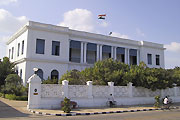 Puducherry (Pondicherry) is a town with a pleasant atmosphere and peaceful charm. It is situated in the union territory of the same name, and had been in French hands for almost three centuries. The French way of life has left its mark, especially in the former colonial district near the waterfront. Pondicherry is also home to the ashram of Sri Aurobindo. Born in Calcutta in 1872, this freedom fighter, yogi and philosopher is one of the great spiritual masters of the 20th century. He developed a method of spiritual practice known as “Integral Yoga”. An evening stroll along the beach promenade offers an opportunity to visit the Gandhi Memorial, a city landmark.
Puducherry (Pondicherry) is a town with a pleasant atmosphere and peaceful charm. It is situated in the union territory of the same name, and had been in French hands for almost three centuries. The French way of life has left its mark, especially in the former colonial district near the waterfront. Pondicherry is also home to the ashram of Sri Aurobindo. Born in Calcutta in 1872, this freedom fighter, yogi and philosopher is one of the great spiritual masters of the 20th century. He developed a method of spiritual practice known as “Integral Yoga”. An evening stroll along the beach promenade offers an opportunity to visit the Gandhi Memorial, a city landmark.
Day 5: Trip to Auroville – Inspiring Insights into the “City of Dawn”
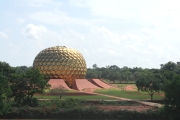 The Integral Yoga of Sri Aurobindo forms the underlying spiritual foundation of Auroville, an international township in the making, founded in 1968. About 2400 members from over 45 nations reside there. The aim of the community is the realization of human unity through the process of a collaborative effort to build the city. The spiritual center is the Matrimandir, a spherical building with a rather extraordinary meditation room. The Visitor’s Information Centre offers exhibitions and video tutorials, giving visitors a comprehensive overview of the ideal and the activities of Auroville. On request, a free pass is issued for a visit to the “Viewing Terrace” in the Matrimandir garden.
The Integral Yoga of Sri Aurobindo forms the underlying spiritual foundation of Auroville, an international township in the making, founded in 1968. About 2400 members from over 45 nations reside there. The aim of the community is the realization of human unity through the process of a collaborative effort to build the city. The spiritual center is the Matrimandir, a spherical building with a rather extraordinary meditation room. The Visitor’s Information Centre offers exhibitions and video tutorials, giving visitors a comprehensive overview of the ideal and the activities of Auroville. On request, a free pass is issued for a visit to the “Viewing Terrace” in the Matrimandir garden.
Day 6: Transfer to Thanjavur – En route visits to Chidambaram and Gangaikondacholapuram
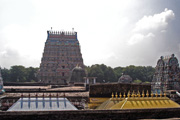 Surrounded by four imposing temple towers, the Nataraja temple in Chidambaram is one of the holiest places in South India. Numerous ceremonies and a traditional atmosphere offer fascinating insight into the ritualized world of Hinduism. Shiva is worshiped here in the form of Nataraja who expresses five forces through his cosmic dance: creation, preservation, destruction, illusion and grace. The construction of the 600 x 495 m large temple complex was started in the 10th century by the Chola dynasty. Characteristic of the Dravidian style is a rectangular floor plan and a firm geometric structure. The 40 m high gopurams (gateway towers) form the entrance gateways to the courtyard, which contains the central sanctum, the temple pond and several secondary shrines. The western and eastern gateways are decorated with the entire 108 basic positions of South Indian Bharatanatyam dance.
Surrounded by four imposing temple towers, the Nataraja temple in Chidambaram is one of the holiest places in South India. Numerous ceremonies and a traditional atmosphere offer fascinating insight into the ritualized world of Hinduism. Shiva is worshiped here in the form of Nataraja who expresses five forces through his cosmic dance: creation, preservation, destruction, illusion and grace. The construction of the 600 x 495 m large temple complex was started in the 10th century by the Chola dynasty. Characteristic of the Dravidian style is a rectangular floor plan and a firm geometric structure. The 40 m high gopurams (gateway towers) form the entrance gateways to the courtyard, which contains the central sanctum, the temple pond and several secondary shrines. The western and eastern gateways are decorated with the entire 108 basic positions of South Indian Bharatanatyam dance.
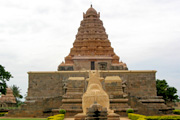 Gangaikondacholapuram means “the town of the Chola (ruler) who conquered Ganga”. Here, after a successful military campaign, the Chola ruler Rajendra I established a new capital in the 11th century and erected in its center an elegant, spacious temple complex with a 60 m high structure (Vimana) on top of the main sanctuary. After his death, the city passed into oblivion; the perimeter wall and the entrance tower of the temple were used as a quarry. Today, only the main sanctuary still stands, with its somewhat concavely curved Vimana, in the center of a well kept complex. Niche sculptures of unique elegance attest to the excellent understanding of art during the Chola era and present a broad spectrum of Hindu Gods. The complex has been a UNESCO World Heritage Site since 2004.
Gangaikondacholapuram means “the town of the Chola (ruler) who conquered Ganga”. Here, after a successful military campaign, the Chola ruler Rajendra I established a new capital in the 11th century and erected in its center an elegant, spacious temple complex with a 60 m high structure (Vimana) on top of the main sanctuary. After his death, the city passed into oblivion; the perimeter wall and the entrance tower of the temple were used as a quarry. Today, only the main sanctuary still stands, with its somewhat concavely curved Vimana, in the center of a well kept complex. Niche sculptures of unique elegance attest to the excellent understanding of art during the Chola era and present a broad spectrum of Hindu Gods. The complex has been a UNESCO World Heritage Site since 2004.
Day 7: World Heritage Site Thanjavur – Art Gallery & Brihadeeswarar Temple
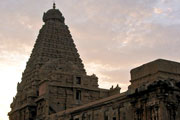 Thanjavur represents South Indian advanced civilization and has now become a World Heritage Site. The art gallery in the Nayak Palace has an impressive collection of ancient bronzes from the Chola period and is known worldwide. The Brihadeeswarar temple, dedicated to Lord Shiva, was built in a record time of 6 years at the end of the 10th century by the Chola ruler Rajaraja I, and is regarded as a sublime masterpiece of Dravidian temple architecture. The site is characterized by its balanced design. After passing two entrance towers guarded by stern-looking dwarapalakas (door guards), the visitor enters a spacious courtyard with the majestic sanctuary at its center. The 16-storey structure above the main chamber is crowned by an 80-ton monolithic dome. After sunset, the temple complex is illuminated by spotlights, emanating an almost mystical atmosphere.
Thanjavur represents South Indian advanced civilization and has now become a World Heritage Site. The art gallery in the Nayak Palace has an impressive collection of ancient bronzes from the Chola period and is known worldwide. The Brihadeeswarar temple, dedicated to Lord Shiva, was built in a record time of 6 years at the end of the 10th century by the Chola ruler Rajaraja I, and is regarded as a sublime masterpiece of Dravidian temple architecture. The site is characterized by its balanced design. After passing two entrance towers guarded by stern-looking dwarapalakas (door guards), the visitor enters a spacious courtyard with the majestic sanctuary at its center. The 16-storey structure above the main chamber is crowned by an 80-ton monolithic dome. After sunset, the temple complex is illuminated by spotlights, emanating an almost mystical atmosphere.
Day 8: Transfer to Madurai – Meenakshi Temple – Highlight of Dravidian temple architecture
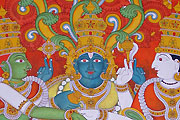 According to mythology, in Madurai Shiva took his consort Parvati to wife in the form of the beautiful Pandya princess Meenakshi. The Meenakshi temple, built in the 16th century during the Nayak period, represents the late stage of Dravidian temple architecture. Towards the north is the Sundareswarar temple, dedicated to Shiva in the form of Sundareswar, the beautiful lord. Both temples are part of an impressive overall complex which draws the visitor into a mystical world with the bright and colorful decoration of its temple towers, the half-dark colonnades, the traditional processions, the illuminated side shrines and the abundance of mythological motifs. Also worth seeing are the temple museum and the market with devotional items, housed in two large temple halls, where many pilgrims buy their souvenirs. Other attractions in Madurai are the Thirumalai Nayak Palace, built in the 17th century in Indo-Saracenic style, and the Gandhi Memorial Museum.
According to mythology, in Madurai Shiva took his consort Parvati to wife in the form of the beautiful Pandya princess Meenakshi. The Meenakshi temple, built in the 16th century during the Nayak period, represents the late stage of Dravidian temple architecture. Towards the north is the Sundareswarar temple, dedicated to Shiva in the form of Sundareswar, the beautiful lord. Both temples are part of an impressive overall complex which draws the visitor into a mystical world with the bright and colorful decoration of its temple towers, the half-dark colonnades, the traditional processions, the illuminated side shrines and the abundance of mythological motifs. Also worth seeing are the temple museum and the market with devotional items, housed in two large temple halls, where many pilgrims buy their souvenirs. Other attractions in Madurai are the Thirumalai Nayak Palace, built in the 17th century in Indo-Saracenic style, and the Gandhi Memorial Museum.
Day 9 and 10: Transfer to Munnar – Visit to the tea museum & hiking in the tea fields
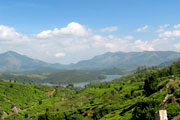 A varied drive through the picturesque countryside of southern India leads to a true paradise for nature lovers. Munnar, the “Queen of Hill Stations”, is surrounded by lush green tea plants at an altitude of 1,524 meters in the Kannan Devan hills of the Western Ghats. In the immediate vicinity is the Anamudi, the highest peak in South India at 2,965 m. The area around Munnar offers breathtaking views of the manicured tea fields that, depending on the weather, will glitter in the mild mountain sunlight or be enveloped in the mystical white of the clouds. A tea of a very special quality matures here, and the air is often permeated by the scent of freshly picked tea leaves. The area captivates, with its white-water streams, vast tea gardens, breathtaking views and rich animal life. A trip to Echo Point and Top Station will go past the scenic highlights of the region. A walk through the tea plantations with a local guide is highly recommended. A visit to the local tea museum reveals the secrets of tea production.
A varied drive through the picturesque countryside of southern India leads to a true paradise for nature lovers. Munnar, the “Queen of Hill Stations”, is surrounded by lush green tea plants at an altitude of 1,524 meters in the Kannan Devan hills of the Western Ghats. In the immediate vicinity is the Anamudi, the highest peak in South India at 2,965 m. The area around Munnar offers breathtaking views of the manicured tea fields that, depending on the weather, will glitter in the mild mountain sunlight or be enveloped in the mystical white of the clouds. A tea of a very special quality matures here, and the air is often permeated by the scent of freshly picked tea leaves. The area captivates, with its white-water streams, vast tea gardens, breathtaking views and rich animal life. A trip to Echo Point and Top Station will go past the scenic highlights of the region. A walk through the tea plantations with a local guide is highly recommended. A visit to the local tea museum reveals the secrets of tea production.
Day 11 and 12: Transfer to Thekkady – Spice gardens in the land where pepper grows – Hiking in Periyar National Park
 In Thekkady, you are in the land where the pepper grows. The small town is nestled between green tea, coffee and spice plantations in a typical South-Indian hilly landscape. Thekkady is probably the best place for buying Indian spices of the highest quality. On a visit to one of the many spice gardens, the various traditional spices can be directly experienced in nature, under the guidance of a professional. Another attraction is the Periyar National Park, which is among the best-known nature and wildlife sanctuaries in South India. On an early morning hike with local guides or on a boat ride on Periyar Lake, one can – with a little luck – spot elephants and a variety of other wild animals. A visit to a Kalaripayattu demonstration is also an impressive experience, providing insight into the traditional martial art of South India.
In Thekkady, you are in the land where the pepper grows. The small town is nestled between green tea, coffee and spice plantations in a typical South-Indian hilly landscape. Thekkady is probably the best place for buying Indian spices of the highest quality. On a visit to one of the many spice gardens, the various traditional spices can be directly experienced in nature, under the guidance of a professional. Another attraction is the Periyar National Park, which is among the best-known nature and wildlife sanctuaries in South India. On an early morning hike with local guides or on a boat ride on Periyar Lake, one can – with a little luck – spot elephants and a variety of other wild animals. A visit to a Kalaripayattu demonstration is also an impressive experience, providing insight into the traditional martial art of South India.
Day 13: Transfer to Alappuzha (Alleppey) – House boat trip on the backwaters
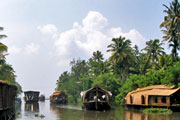 Kerala is famous around the world for its numerous waterways; lined by palms, mango trees and rice paddies, they crisscross the region and are known as the ‘backwaters’. They form a vast network of waterways that extends from Kochi in the north to Kollam in the south, crossing an area of about 2000 square kilometers, consisting of 29 lakes and lagoons, 44 rivers and about 1500 canals. The largest lake, with a length of 83 km, is Vembanad Lake, which is connected to the Arabian Sea. The peaceful backwaters, serving as trade and transport routes for the locals for many centuries, are a spectacular destination for tourists. Discovering the picturesque water world on a house boat trip is an unforgettable highlight of a trip to Kerala. The romantic boats, providing all meals and comfortable accommodation for the night, are converted former rice barges. Your backwater trip starts and ends at the Alappuzha (Alleppey) boat jetty.
Kerala is famous around the world for its numerous waterways; lined by palms, mango trees and rice paddies, they crisscross the region and are known as the ‘backwaters’. They form a vast network of waterways that extends from Kochi in the north to Kollam in the south, crossing an area of about 2000 square kilometers, consisting of 29 lakes and lagoons, 44 rivers and about 1500 canals. The largest lake, with a length of 83 km, is Vembanad Lake, which is connected to the Arabian Sea. The peaceful backwaters, serving as trade and transport routes for the locals for many centuries, are a spectacular destination for tourists. Discovering the picturesque water world on a house boat trip is an unforgettable highlight of a trip to Kerala. The romantic boats, providing all meals and comfortable accommodation for the night, are converted former rice barges. Your backwater trip starts and ends at the Alappuzha (Alleppey) boat jetty.
Day 14: Transfer to Kochi (Cochin) – Cultural diversity on the Malabar coast
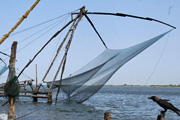 The port city of Kochi, formerly known as Cochin, is uniquely located between the Arabian Sea and the backwaters. With its rich ethnic and cultural heritage, Kochi’s atmosphere is an unforgettable experience. A variety of attractions offer insights into the rich history of the city, characterized by strong Portuguese and Dutch influences. Particularly interesting is a visit to Mattancherry and Fort Kochi, the historical city with its bustling life. Among the attractions for which sufficient time should be reserved are the winding streets with old Dutch houses, Chinese fishing nets at the waterfront, traditional spice markets, the antiquities quarter, the Jewish synagogue, the Mattancherry palace with its exquisite mythological murals and the St. Francis Church, built in 1503, where Vasco da Gama was buried until his remains were transferred to Lisbon in 1539. A special cultural attraction is the spectacular Kathakali dance theater. There are performances every evening.
The port city of Kochi, formerly known as Cochin, is uniquely located between the Arabian Sea and the backwaters. With its rich ethnic and cultural heritage, Kochi’s atmosphere is an unforgettable experience. A variety of attractions offer insights into the rich history of the city, characterized by strong Portuguese and Dutch influences. Particularly interesting is a visit to Mattancherry and Fort Kochi, the historical city with its bustling life. Among the attractions for which sufficient time should be reserved are the winding streets with old Dutch houses, Chinese fishing nets at the waterfront, traditional spice markets, the antiquities quarter, the Jewish synagogue, the Mattancherry palace with its exquisite mythological murals and the St. Francis Church, built in 1503, where Vasco da Gama was buried until his remains were transferred to Lisbon in 1539. A special cultural attraction is the spectacular Kathakali dance theater. There are performances every evening.
Day 15 – 17: Transfer to Mudumalai – Across the Blue Mountains – Wildlife in the land of the wild elephants
 The transfer to Mudumalai goes right across the Nilgiris, the “Blue Mountains” of South India. Especially scenic is the drive up to the hill station of Ooty, located at an altitude of 2300 m. The road winding down from Ooty to Mudumalai, which descends by 1,200 m in a few kilometers and features 36 hairpin bends, is a thrilling experience.
The transfer to Mudumalai goes right across the Nilgiris, the “Blue Mountains” of South India. Especially scenic is the drive up to the hill station of Ooty, located at an altitude of 2300 m. The road winding down from Ooty to Mudumalai, which descends by 1,200 m in a few kilometers and features 36 hairpin bends, is a thrilling experience.
Mudumalai Wildlife Park, within the territory of Tamil Nadu, is situated in the northern foothills of the Nilgiri mountains and covers a total area of 320 km ². It is bordered on the western and northern side by the wildlife sanctuaries of Bandipur (Karnataka) and Wayanad (Kerala), and is covered largely by tropical dry forest with many hardwood trees. The fauna is rich in wildlife species: sambar deer, spotted gazelles, blackbucks, antelopes, wild buffalo, elephants, monkeys, wild boar, giant squirrel and occasionally even leopards and tigers. The Moyar River is also a habitat for otters and crocodiles. The lord of the jungle is undoubtedly the wild elephant, which appears in large herds. Work animals for forest management and timber production are kept in an elephant camp. On a multi-hour jeep safari, one can – with some luck – observe wild animals in their free, natural habitat. There is also the possibility of going for hikes with an experienced guide in the vicinity of the wildlife park.
Day 18 & 19: Transfer to Mysore – Maharaja Palace & Chamundi Hills – Excursion to Somnathpur
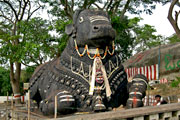 The tradition-imbued, colorful provincial city of Mysore with its princely charm and wide, tree-lined streets is considered one of the most attractive cities in South India. The absolute highlight is the Maharaja’s Palace. Built in Indo-Saracenic style, it has formed the center of the city since its completion in 1912. The magnificent building came into existence after the old wooden palace of the ruling family was completely destroyed by a fire in 1897. Other attractions include the Chamundi Hills with the Durga Temple and the largest monolithic Nandi (Shiva’s bull) statue in South India, Tipu Sultan’s fortress and the Summer Palace of Srirangapatna. Mysore is also known for its silk fabrics, incense, flower essences and sandalwood and rosewood carvings.
The tradition-imbued, colorful provincial city of Mysore with its princely charm and wide, tree-lined streets is considered one of the most attractive cities in South India. The absolute highlight is the Maharaja’s Palace. Built in Indo-Saracenic style, it has formed the center of the city since its completion in 1912. The magnificent building came into existence after the old wooden palace of the ruling family was completely destroyed by a fire in 1897. Other attractions include the Chamundi Hills with the Durga Temple and the largest monolithic Nandi (Shiva’s bull) statue in South India, Tipu Sultan’s fortress and the Summer Palace of Srirangapatna. Mysore is also known for its silk fabrics, incense, flower essences and sandalwood and rosewood carvings.
The Keshava temple of Somnatpur, located 35 km east of Mysore, is considered a particularly great and well-preserved architectural masterpiece of the Hoysala dynasty. The complex was built in 1268 by Somnatha, a general in the army of Hoysala ruler Narasimha III. The three shrines, dedicated to different aspects of the Hindu God Vishnu, are situated in a rectangular courtyard and designed in a star-shaped layout, with friezes that have exquisite ornamental decorations and scenes from the Indian epics. All the sculpturing work is of outstanding quality.
Day 20: Transfer to Hassan – Tour of Halebid and Belur – Filigree Hoysala srines
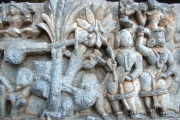 From the 12th to the 14th century, Halebidu was – under the name Dorasamudra – the capital of the Hoysala dynasty, during which fascinating shrines were built in a picturesque landscape. The Hoysaleshwara Temple is a double shrine dedicated to Shiva. The two units each stand on a cross-shaped ground plan and are connected by a hall. Inside the sanctuary, hand-turned stone columns support the roof. Wall elements of perforated stone filter the incident rays of light, creating a pleasant atmosphere. The design of the exterior walls is characterized by grandiose mythological motifs, presenting the entire Hindu pantheon. Overlapping friezes show elephants, lions, plant ornaments and episodes from the Indian epics.
From the 12th to the 14th century, Halebidu was – under the name Dorasamudra – the capital of the Hoysala dynasty, during which fascinating shrines were built in a picturesque landscape. The Hoysaleshwara Temple is a double shrine dedicated to Shiva. The two units each stand on a cross-shaped ground plan and are connected by a hall. Inside the sanctuary, hand-turned stone columns support the roof. Wall elements of perforated stone filter the incident rays of light, creating a pleasant atmosphere. The design of the exterior walls is characterized by grandiose mythological motifs, presenting the entire Hindu pantheon. Overlapping friezes show elephants, lions, plant ornaments and episodes from the Indian epics.
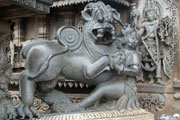 From the 11th to the 13th century, Belur was an important center of the Hoysala dynasty. Erected on a jagged base, the Chennakeshwara Temple, which is still being used for religious purposes today, is dedicated to the God Vishnu in the form of Keshvara (“the one with the beautiful curls”). Surrounded by smaller shrines and walkways with stone columns, it stands in the middle of a wide courtyard surrounded by a wall. Construction of the temple went on for 103 years. The admirable sculptures are of an exquisitely delicate nature and deserve proper attention. The geometrically designed cross-shaped ground plan, the buoyant sculptures of the Gods, the wide conversion zone, the high base and surrounding friezes with mythological motifs are some of the elements typical of Hoysala architecture.
From the 11th to the 13th century, Belur was an important center of the Hoysala dynasty. Erected on a jagged base, the Chennakeshwara Temple, which is still being used for religious purposes today, is dedicated to the God Vishnu in the form of Keshvara (“the one with the beautiful curls”). Surrounded by smaller shrines and walkways with stone columns, it stands in the middle of a wide courtyard surrounded by a wall. Construction of the temple went on for 103 years. The admirable sculptures are of an exquisitely delicate nature and deserve proper attention. The geometrically designed cross-shaped ground plan, the buoyant sculptures of the Gods, the wide conversion zone, the high base and surrounding friezes with mythological motifs are some of the elements typical of Hoysala architecture.
Day 21: Transfer to Bangalore – En route visit to Shravanabelagola – Return home or travel onwards
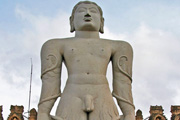 Shravanabelagola has one of the oldest and most significant centers of the Jain religion, which has a spiritual tradition that emphasizes the aspects of nonviolence, internalization and asceticism. At the top of the Indragiri hill stands the famous 17 meter high monolithic statue of Lord Gomateshwara (also known as Bahubali), which represents a complete immersion into the eternal. Tendrils wrap themselves around the legs of the saint and his expression reflects a deep inner peace. The sanctuary was built in the 10th century. Every 12 years, an elaborate ceremony takes place in Shravanabelagola in which the statue is showered with milk, yogurt, buffalo fat, saffron and gold coins. Other Jain temples from the 9th – 12th century are located on the adjacent Chandragiri Hill.
Shravanabelagola has one of the oldest and most significant centers of the Jain religion, which has a spiritual tradition that emphasizes the aspects of nonviolence, internalization and asceticism. At the top of the Indragiri hill stands the famous 17 meter high monolithic statue of Lord Gomateshwara (also known as Bahubali), which represents a complete immersion into the eternal. Tendrils wrap themselves around the legs of the saint and his expression reflects a deep inner peace. The sanctuary was built in the 10th century. Every 12 years, an elaborate ceremony takes place in Shravanabelagola in which the statue is showered with milk, yogurt, buffalo fat, saffron and gold coins. Other Jain temples from the 9th – 12th century are located on the adjacent Chandragiri Hill.
In the evening, in Bangalore, a transfer is made to the train station or airport to return home or travel onwards, as per your preferred arrangement.
